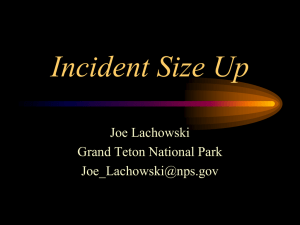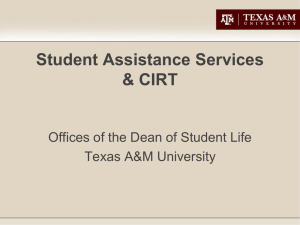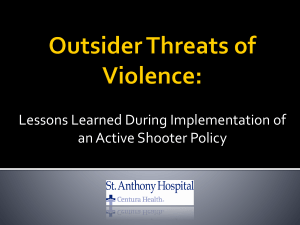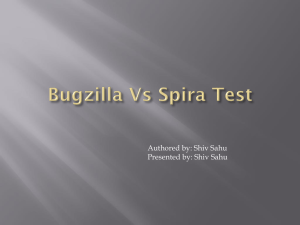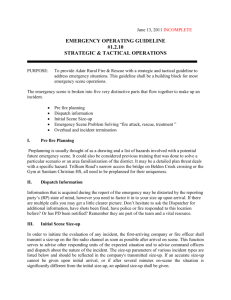Incident Command Mini Intro
advertisement
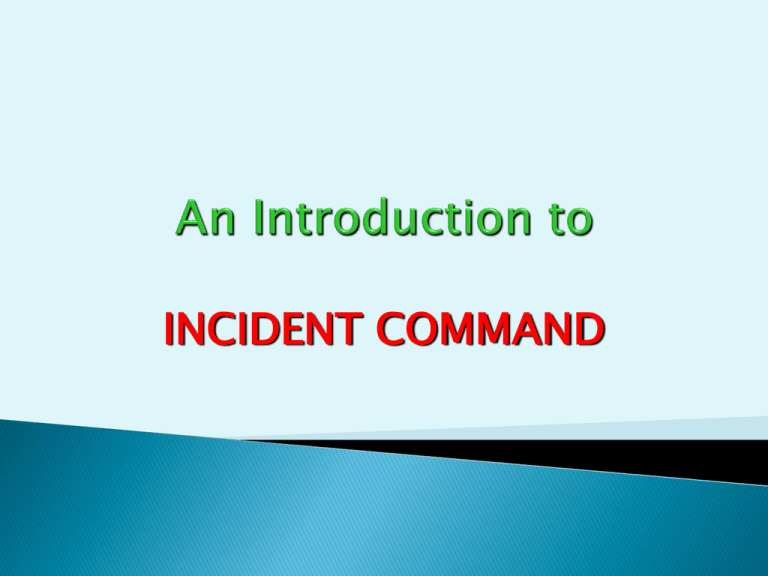
INCIDENT COMMAND 1. 2. 3. 4. 5. 6. Incident Management System (IMS) and the Incident commander Risk management Fire confinement and extinguishment Size up Accountability and PAR’s PIAR’s – post incident analysis reviews 1. One person in command • IC’s may change, but always, only ONE person in charge 2. Ensures that a strong command is visible 3. Establishes an effective organization 4. Provides a system for processing information • IC, even at a simple house fire, can be overloaded with information 5. Allows for an orderly Transfer of Command 6. Ensures the maximum level of firefighter safety • accountability What is the primary responsibility of the IC? 1. To ensure that the Tactical Priorities are met. 1. Rescue 2. Stabilize the scene i.e. extinguishment etc. 3. Property Conservation 4. Firefighter Safety – ongoing throughout the incident What does the IC have to do on arrival & while on scene? 1. 2. 3. 4. 5. Assume command and announce it!!! Do a quick size-up Set up a Command Post and announce it!!! Initiate and control communications Determine strategy and develop the Action Plan • assign companies 6. Develop an effective Incident Management organization 7. Provide the Tactical Priorities 8. Provide continuity in Transfer and Termination of Command It is critical to understand the use and importance of “Benchmarks” in the Incident Management System. We may accomplish the tactical priorities out of order but that doesn’t change the way we rank their importance. As a result, the following benchmarks are always reported in the following order: • Primary Search – All Clear • Under Control (meaning, fire) • Secondary Search – All Clear • Loss Stopped (meaning, no more damage) Whatever the incident, there are always 3 levels of command… 1. Strategic – the big plan 2. Tactical – operations 3. Task – performance At the Strategic level, there are 3 terms that are indicative of the IC’s overall approach to the incident. They are… Offensive – Aggressive, usually interior, fire attack that is intended to stop the fire at its current location Defensive – Exterior fire attack with emphasis on exposure protection. The commitment of a fire department’s resources to protect exposures when the fire has progressed to a point where an offensive attack is not effective. Marginal – Many times offensive/defensive conditions are clear cut and Command can quickly determine the appropriate strategy. In other cases, the situation is MARGINAL and Command must initiate an offensive interior attack, while setting up defensive positions on the exterior. 2 Story Detached Dwelling Pump 3 Garage Pump 1 Rescue 1 Pump 2 D/Chief Chief Strategic Level – Incident Commander…. Develop Action Plan: determine strategy & overall incident objectives; set priorities; obtain & assign resources; predict outcomes and planning; assign specific objectives to the Tactical Level 2 Story Detached Dwelling Pump 3 Garage Pump 1 Rescue 1 Pump 2 D/Chief Chief Tactical Level – Captain…. Direct activities toward specific objectives: responsible for geographic “areas” or functions; has responsibility & authority to meet strategic goals 2 Story Detached Dwelling Pump 3 Garage Pump 1 Rescue 1 Pump 2 D/Chief Chief Task Level – firefighters…. Individual companies – “where the rubber meets the road”: usually commanded by a company Officer; goal is to accomplish tactical objectives Any Questions to this Point??? What does the term “sectoring” mean to you? Why would we use sectoring and what are the types? Types: Geographical Function Often used in conjunction with locations around a structure. Can be termed either: Alfa – Bravo – Charlie – Delta or South – West – North – East Your thoughts on which method is best? C (3) B (2) HOUSE GARAGE A (1) STREET D (4) Identities are assigned based on the task. Can be termed as follows: Search & Rescue Team 1 Suppression Team 1 Ventilation 1 Water Supply How does all of this look organizationally? Should there not be differences between small, medium and large scale incidents? “Span of Control” criterion: once over 3-5 FF’s In fact, there are differences…but, some important similarities as well. EXAMPLE #1 P1 P1 EXAMPLE #2 CO CO P2 R1 EXAMPLE #3 IC DISTRICT CHIEF CO’S CO CHIEF DISTRICT CHIEF VENTILATION SECTOR R1 CO P2 FIRE CONTROL SECTOR P3 CO’S A1 Usually the first arriving Officer stays in Command until a transfer or the scene is stabilized. Question: The first on-scene Officer has been in control of an incident since the start. He/she is doing a good job. A more senior Officer arrives at the scene but chooses not to assume Command because the first Officer is doing well. Who is responsible for the fire? What are your thoughts? • • • • • • • • • Vehicle designation – “P-1 Arrived” Address – “20 Spruce St.” Building type – “2-story residential brick structure” Obvious conditions – “smoke showing at front” Initial actions taken – “have established water supply and beginning primary search” Declaration of Strategy “commencing Offensive Attack” Obvious safety concerns – “heavy traffic, need police” Assume command & give location – “Capt. Sparky establishing Command, Alfa-Delta side” Request or release resources – “Control, Spruce Command. Dispatch EMS to this location” There are 3 possible Command Modes upon arrival: 1. Nothing Showing Mode 2. Fast Attack Mode 3. Command Mode … also known as “Investigative Mode” What are some features of this mode? • Take crew, portable radio and check out the situation • Stage additional arriving apparatus “What you do in the first 5 minutes often determines what you will be doing for the next 5 hours.” - Brunacini What are some features of this mode? • Situations where immediate action is required • Retain radio and maintain Command • Should not last longer than a few minutes – you cannot maintain Command from inside a structure What kind of incidents would require establishing Command Mode immediately? • Situations that are obviously large from the outset • IC establishes a Command Post immediately • A “Tactical Worksheet” is activated at this point! Now let’s take a look at Risk Management There will always be risk in the job we do. However, needless risk is unacceptable as it both injures and kills firefighters. Who is responsible for assessing risk at an emergency scene? i. First arriving Officer ii. All firefighters and Officers iii. Ultimately, the IC Who determines the level of acceptable risk? • • The IC has to determine the level of acceptable risk based on an on-going size-up He must ensure that acceptable levels are NOT exceeded What is an “acceptable” level of risk? • Significant calculated risk to save a life • Some risk to save property • NO RISK to save something that can’t be saved 1. Does the size, location and size of the fire warrant an offensive fire attack? 2. Do I have enough resources to carry out an offensive plan of attack? (human, physical – i.e. equipment/apparatus) 3. Is there rescue to perform? (rescue risks higher acceptability than suppression risks) 4. Should attack be delayed pending additional manpower? (If the answer is yes then all activities must be limited to the exterior) 1. Conduct a thorough size-up. (What are some ways to do this?) 2. Determine strategic and tactical objectives. (What’s the difference between “strategy” and “tactics?” 3. Determine initial attack. (Offensive or defensive) 4. Develop an Action Plan. • Driven by Risk Management • IC must weigh the danger or risks against the expected results • Contains Strategic and Tactical Objectives • Must be flexible and changeable based on changing conditions • Must have identifiable benchmarks or objectives Fire Confinement and Extinguishment The goal of the fire ground IC is ultimately to put the fire out. This is not always possible in the short term. Hose lines could be used in a “holding pattern.” There IS a difference between Confinement and Extinguishment. Question: What IS this difference? 1. CONFINE OR EXTINGUISH? 2. SIZE-UP CONSIDERATIONS - WHERE IS IT GOING? - WHO OR WHAT IS IN THE WAY? - TYPE OF CONSTRUCTION - REQUIRED FLOW? UNDER CONTROL - LOSS STOPPED - “BENCHMARKS” WHERE? WHAT? HOW? • Depends on function… confinement or extinguishment • Initial line between fire and victims • Frontal assault only when no other option is possible • Use with second line to push fire back to place of origin Benchmarks “Under Control” “Loss Stopped” Size Up and Exposure Protection Initial size-ups must be viewed as just that: initial. It must be an on-going process. Among the important decisions to be made relates to protection from exposures. More troops may be needed! Question: When does size-up begin? Begins on Receipt of Alarm 1. Time of day or night 2. Weather – wind conditions, humidity etc. 3. Type of occupancy 4. Nature of the emergency i.e. working fire? 5. Other apparatus responding 6. Reports from citizens En Route 1. Pre-plan factors • • • • • • • • • Size & type of building Building construction including roof Water supply Company assignments Fire protection system connections Access points Normal building population Fire protection equipment i.e. standpipe etc. Fire flow required On Arrival 1. Fire Ground Situational Factors • • • • • Location, stage and extent of fire Colour of smoke Obstructions to operations Apparatus on scene People trapped? Question: What other factors could there be? 1. 2. 3. 4. 5. 6. 7. 8. SIZE-UP CALL FOR HELP LIFE SAFETY - RESCUE CONFINEMENT - EXPOSURES EXTINGUISHMENT VENTILATION SALVAGE OVERHAUL WHAT? HOW? WHERE ? 1. IS SUPPORT NEEDED? 2. OUTSIDE COLLAPSE ZONE? 3. FIRE FLOW AVAILABE? 4. HOSE AND APPLIANCES REQUIRED? 5. WHAT COORDINATION WITH OTHER TACTICS IS NEEDED? 6. SAFETY CONCERNS? WHERE? WHAT? HOW? Accountability and Personnel Accountability Reports (PAR’s) Its primary purpose is FIREFIGHTER SAFETY! The IC is ultimately responsible for safety. Some departments have ISO’s and safety MUST be part of OG’s. All FF’s and Officers must comply with safety guidelines. Accountability Officer • Keeps track of who is at the scene • Collect first Tag • Will sometimes be Entry Control Officer as well Entry Control Officer • Records when FF’s enter the danger zone • Generally uses a pre-fabricated Entry Control Board • Reports to the IC and gives updates or notifies the IC of any unaccounted for FF’s The purpose is to assist the IC in a person Inventory Control. There are 8 appropriate times to call for a PAR… 1. When “Benchmarks” have been achieved “All Clear” and “Under Control” Easy reminder for IC Good delineation of the event 2. After twenty and forty minutes 30 and 60 minute bottles Some time to begin rescue if a firefighter is missing Note: Some departments require the initial attack crew entering a building to radio to the IC or their Dispatch that they are “ON AIR” when they turn their cylinders on. This is to provide the IC and the Dispatch the reminder that the “clock is now ticking” in the countdown to a PAR. 3. When command is Passed or Transferred This allows the new IC to be confident that all crews are accounted for 4. When there is a significant change Building collapse Flashover Backdraft Rapid smoke build-up Any other important event 5. After an ordered evacuation 6. Anytime Personnel go Missing Activated PASS alarm From radio report From other source Prior to activating RIT 7. After the rescue of a firefighter who was previously missing This is a good time to “take stock” 8. After a major change of strategy It’s crucial to know everyone is out of the building prior to initiating significant defensive tactics that affect the internal environment PIAR’s Post Incident Analysis Reviews “We need to learn from each experience” The purpose is to improve performance and safety! Let’s take a closer look at what P.I.A.R. is all about… Why do you do Post Incident Analysis? To give credit where credit is due To point out concerns to the team To analyze tactics – good and bad It’s a good place for “soft intervention” To obtain feedback from all those involved Above all: TO IMPROVE PERFORMANCE! Who conducts a Post Incident Analysis? Chief IC Safety Officer Outside Facilitator When do you do a Post Incident Analysis? As soon as possible after the incident Time clouds the memory This is a good reason for all personnel to take notes Everyone involved in the incident, if possible… This may include… IC Firefighters Police EMS Dispatch etc… As long as practicable to ensure performance is improved. (The first few PIAR’s a department does may take a little longer than subsequent PIAR’s.) People may be reluctant at first Remind participants that questions should be posed in a non-accusational manner It may depend on the “culture” of the department The purpose of a PIAR is to IMPROVE PERFORMANCE and NOTHING ELSE! Incident Management System (IMS) and the Incident Commander Risk Management Fire Confinement Size Up Accountability PIAR

